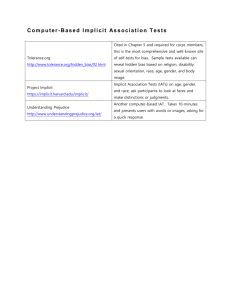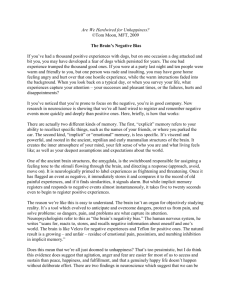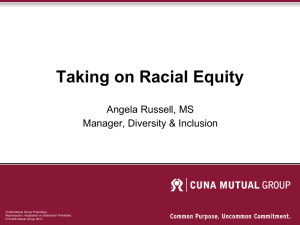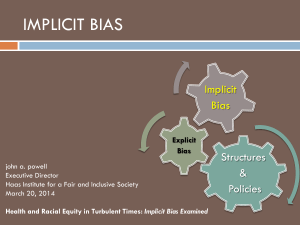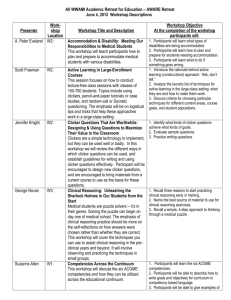Breakout Sessions PowerPoint
advertisement
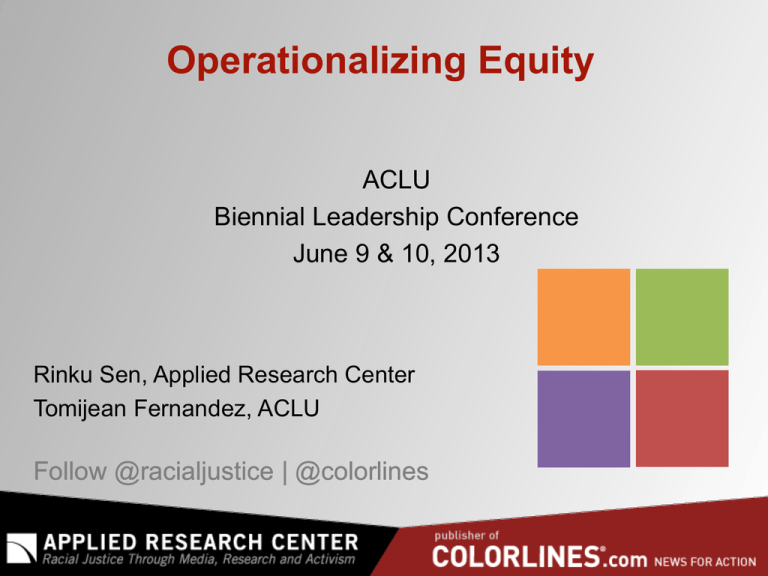
Operationalizing Equity ACLU Biennial Leadership Conference June 9 & 10, 2013 Rinku Sen, Applied Research Center Tomijean Fernandez, ACLU Follow @racialjustice | @colorlines Agenda Overview 1. Analyzing Issues around Equity 2. The Implicit Bias/Inequity Connection 3. Operationalizing Equity a) Analyzing Choice Points b) Reflecting on Possible Solutions Analyzing Equity • It puts ‘isms’ in the foreground of the debate. • It addresses ‘isms explicitly, but not necessarily exclusively. Basic Elements of Analysis • What’s the PROBLEM? • Who’s/What’s RESPONSIBLE? • What’s the SOLUTION? • What’s the needed ACTION? • What VALUES are at stake? IMPLICIT BIAS • Implicit biases are pervasive • People are often unaware of their implicit bias • Implicit biases predict behavior • People differ in levels of implicit bias Source: Project Implicit (www.projectimplicit.net) IMPLICIT BIAS IS INDIVIDUAL AND INSTITUTIONAL • A lot of contemporary racism occurs without intention or malice. It does not require “racists.” Implicit bias helps explain how racism can be subtle in appearance but significant in impact. • In institutions, the bias of individuals is routinely replicated through collective decisions and actions. It becomes compounded unless it’s consciously counteracted. • “Implicit Bias…offers the idea that discrimination and bias are social, rather than individual issues, and that we can thus all participate in promoting equality.” -American Values Project EXAMPLES OF IMPLICIT BIAS • Managers are less likely to call back or hire members of a different ethnic group. • NBA referees are more likely to subtly favor players with whom they share a racial identity. • A white male with a felony conviction is more likely to be brought back for a second interview than a black male high school graduate. Source: http://writers.unconsciousbias.org/unconsciousbias/ CHOICE POINTS: THE CROSSROADS TO CHANGE CHOICE POINTS • Choice points are decision-making opportunities that influence outcomes. • The cumulative impacts of many small choices can be as significant as the impacts of big decisions. • When we’re conscious of choice points and the related impacts, we’re less likely to replicate implicit bias and the status quo, and we open new possibilities for equitable change. CHOOSING THE PATH AND TAKING STEPS TOWARDS EQUITY SAME OUTCOMES: SAME OLD CHOICES & ACTIONS INEQUITY, EXCLUSION, PERPETUATION OF ‘ISMS’ CHOICE POINT DIFFERENT OUTCOMES: EQUITY-DRIVEN CHOICES & ACTIONS EQUITY, INCLUSION, PREVENTION OF ‘ISMS’ EXAMPLES OF ORGANIZATIONALCHOICE POINTS Making annual budgets Planning monthly staff meetings Choosing new campaigns/projects Responding to press calls Designing board meetings CHOICE POINTS AT THE ACLU Decision points where discretion is exercised that may produce a disparate impact: • Operations and Management • Governance • Program – Communications and Public Education – Advocacy – Legal USING CHOICE POINTS TO ADVANCE EQUITY & INCLUSION 1. Where are the decision-making points that affect outcomes? 2. What decisions/actions may be reinforcing the status quo, implicit bias and current inequities? 3. What alternative action options could produce different outcomes? 4. Which action will best advance equity and inclusion? 5. What reminders, supports and accountability systems can be structured into routine practices to keep equity as a high priority? CHOICE POINTS: THE CROSSROADS TO CHANGE Exercise: USING CHOICE POINTS 1. Identify a choice point: For your area of work, what is a choice point where a current decision/course of action may be adversely affecting racial outcomes. 2. Generate alternative actions: For that choice point, identify some alternative actions that could lead to different and more favorable racial outcomes. 3. Select an action: Decide which option could leverage the most equitable change.
